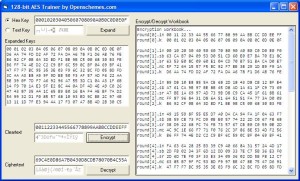AES Encryption
Introduction
AES stands for Advanced Encryption Standard. AES is a symmetric key encryption procedure which will swap the generally utilized Data Encryption Standard (DES). It was the consequence of a worldwide call for submissions of encryption calculations issued by the US Government’s National Institute of Standards and Technology (NIST) in 1997 and finished in 2000. The winning calculation, Rijndael, was produced by two Belgian cryptologists, Vincent Rijmen and Joan Daemen. AES furnishes solid encryption and has been chosen by NIST as a Federal Information Processing Standard in November 2001 (FIPS-197), and in June 2003 the U.s. Government (NSA) reported that AES is secure enough to ensure arranged informative content up to the TOP SECRET level, which is the most noteworthy security level and described as informative data which might cause “astoundingly grave harm” to national security if unveiled to people in general. The AES calculation utilizes one of three figure key qualities: a 128-, 192-, or 256-cycle encryption key (secret key). Every encryption key measure makes the calculation carry on somewhat specially, so the expanding scratch sizes not just offer a bigger number of bits with which you can scramble the information, additionally build the intricacy of the figure calculation.
Bitzipper upholds 128-and 256-cycle encryption keys, which is the two key qualities backed by Winzip 9. Both key qualities give essentially preferred security over standard ZIP 2.0 encryption. It is marginally speedier to encrypt and decrypt information ensured with 128-cycle AES, however with today’s quick Pcs the time contrast is scarcely eminent. AES is dependent upon an outline guideline reputed to be a Substitution stage system. It is quick in both programming and hardware.[6] Unlike its ancestor, DES, AES does not utilize a Feistel system. AES has a settled square size of 128 bits and a key size of 128, 192, or 256 bits, though Rijndael might be specified with piece and enter sizes in any different of 32 bits, with at least 128 bits. The blocksize has a most extreme of 256 bits, however the keysize has no hypothetical greatest. AES works on a 4×4 segment major request network of bytes, termed the state (forms of Rijndael with a bigger piece size have extra segments in the state). Generally AES counts are carried out in an uncommon limited field. The AES figure is specified as various reiterations of change rounds that change over the information plaintext into the last yield of ciphertext. Each round comprises of some transforming steps, incorporating one that relies on upon the encryption key. A set of opposite rounds are connected to convert ciphertext go into the definitive plaintext utilizing the same encryption key. Elevated amount portrayal of the calculation.
1. KEYEXPANSION—adjust keys are determined from the figure key utilizing Rijndael’s key plan
2. INITIAL ROUND
- ADDROUNDKEY—every byte of the state is joined together with the round key utilizing bitwise XOR.
3. ROUNDS
- SUBBYTES—a non-direct substitution step where every byte is reinstated with an alternate as per a lookup table.
- SHIFTROWS—a transposition step where every column of the state is moved cyclically a certain number of steps.
- MIXCOLUMNS—a blending operation which works on the segments of the state, joining together the four bytes in every section.
- ADDROUNDKEY
4. FINAL ROUND (NO MIXCOLUMNS)
- SUBBYTES
- SHIFTROWS
- ADDROUNDKEY
